(story continued from page 1)
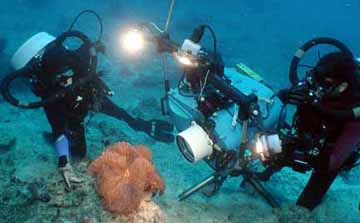 |
| Howard and Mark shoot anenome. |
"Howard, this is the surface, camera is loaded and on it's way. Do you copy?"
"Round and queer"
"Did he say queer? Round and what!"
"Clear. I think it was 'loud and clear'."
As shot scouts and meat puppets, Michele Hall, Cat and I collected various still cameras and other paraphernalia and joined the herd around the day's victim - a goby here, a turtle there, a giant triton devouring a crown of thorns starfish. All were to experience a new level of attention and desperation. Capturing awesome wild animal sequences is Howard's stock-in-trade and key to making a compelling underwater film. We often wondered how he did it and we were about to find out. Deep down we all knew that Howard was luckier than we are. How else could he have caught footage of blue whales slamming their mouths shut on hundreds of gallons of krill just inches from his camera? How else did he happen to be in the right place with an IMAX® camera to catch marlin devouring a bait ball in Island of the Sharks?
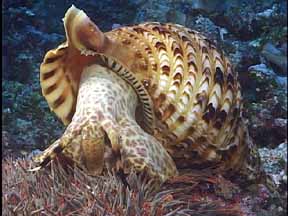 |
| Triton |
|
1 - 2 - Next Page - 4
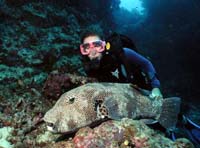 |
Cat and puffer fish.
|
|
But, we had our first clue that there might be more to it than dumb luck when we discussed the logistics of bringing the production to Fiji. To make a 40-minute IMAX® film, not all of which would be shot underwater, it would take five months in the field, require over thirty hours of footage, and cost about $5,000,000. The bill for film and processing would run to 1.5 million alone. Gosh.
With that sort of responsibility hanging over him, Howard was surprisingly laissez faire. He started from the premise that making a wildlife film in IMAX® is absurd, insane, even impossible. So it followed that, with more experience than anyone else in this entirely ludicrous goal of making an IMAX® film underwater, he had a distinct market advantage. That is, no one else would be stupid enough to try it. Coax a fish into doing something exciting in front of a piece of gleaming metal the size of a small car, topped with four stadium lights and surrounded by eight divers? Sure. With only three minutes worth of film in each $3,000 film magazine (which had to be changed in a delicate 10-minute procedure topside), and a lens about as versatile as the 35mm Nikonos lens, the IMAX® rig had some limitations. There was nothing spontaneous or opportunistic - or lucky - about an IMAX® film sequence underwater. Everything was planned and set up - well, almost everything. Howard's only guarantee was that we would all have fun doing it.
He was right. With more time underwater than most of us have spent in our cars - including 1000 hours on closed-circuit rebreathers - Howard's crew were unfazed by standard diver nightmares like bad visibility, strong currents, or inquisitive bull sharks. They thought nothing of waiting two hours for a dartfish to get used to the camera and lights. It barely annoyed them to spend six hours on a single dive to shoot three minutes of footage. And when the manta that they had spent four days patiently waiting for finally settled into the cleaning station - after they had given up and rigged the camera for garden eels, they didn't curse as vehemently I would have. Well, maybe they did. As I've said, a lot of their underwater conversations were unintelligible.
|
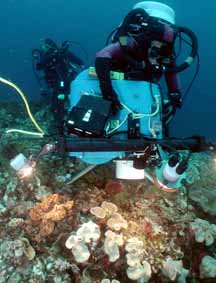 |
| Howard & Bob film close-up of shrimp. |
|
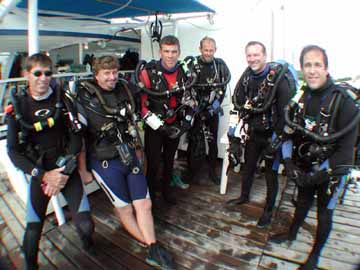 |
| Team Rebreather |
Howard and his crew have developed various tricks and tools to allow them to 'cheat' the IMAX® format's limitations. They use rebreathers to stay down for hours at a time and extend into deeper regions. They have modified the camera housings to go where no IMAX® camera has gone before. They position scouts like us all over the place with animal behaviour shot wish lists. But, of all their gadgetry and game, the coms units provided the most practical gain as well as the best laughs.
Let it be officially stated here that everyone sounded like a fool over the coms. However, Cat's particularly active microphone along with her peculiar Australian accent provided a source of hilarity second only to her habit of finding great animal behaviour in precisely the other direction from the camera crew's activity - and usually up current.
|
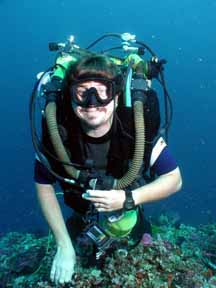 |
| Smile, Plye. |
|